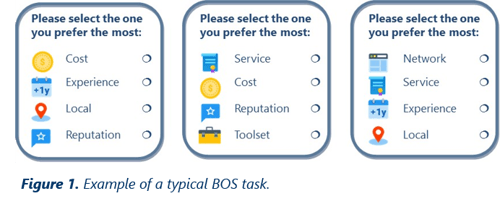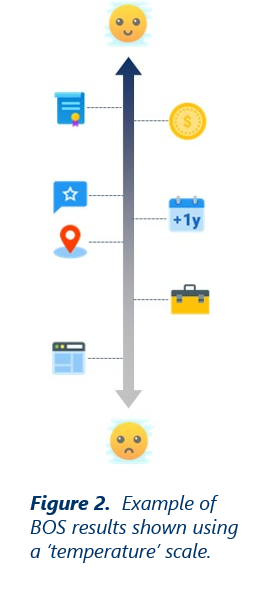
Best Object Scaling
Best Object Scaling
28 September 2020
What is BOS?
Best Object Scaling (BOS) aims to measure the relative preference among a set of objects, features, statements, attributes, brands, concepts, policies, processes, etc. through a series of explicit trade-offs that respondents make using an underlying subjective scale.

Survey respondents are shown a series of items and asked to select the one they prefer the most. This process is repeated several times using different item combinations, and each time the respondent is forced to make a discriminating choice amongst them.
 Results are then aggregated across all respondents revealing a statistically valid scale we can use to measure relative item preference.
Results are then aggregated across all respondents revealing a statistically valid scale we can use to measure relative item preference.
Why BOS?
- Questions are straightforward and simple; we can even administer them via phone.
- A carefully controlled experimental design allows numerous items to be compared without overwhelming respondents.
- The magnitude of the difference between items can be measured, statements such as “item A is twice as preferred as item B, but only half as preferred as item C” can be made.
- An excellent way to quickly evaluate a large number of objects or features (too large for a concept test).
BOS vs. Rating, Ranking, and Constant Sum scales
- Prevents the social desirability bias, scale interpretation bias, and satisficing problems found in rating scales.
- Avoids common ranking scale issues such as order bias, response burden, forced ties, and inability to measure the magnitude of the difference between items.
- Allows proper discrimination based on the magnitude of the differences between items without the cognitive burden and rounding issues of constant sum or allocation scales.
BOS vs. Maxdiff / Best-Worst Scaling
- Maxdiff assumes that when people select their least preferred (worst) item, they are selecting the inverse of their most preferred (best) item. In practice, this is not always the case.
- It can be cumbersome for the respondent to switch back and forth between their most preferred item, then their least preferred item, and then back to their most preferred item.
- Asking only for the most (or least) preferred item means collecting twice as many responses, so we can provide the same analysis for a more limited budget or provide a deeper analysis (comparing between segments) with the same budget.
When can we use BOS?
Product design
Marketing strategies
Optimizing product mix
Prioritizing budget allocation
Proof of concept
Policy management
Risk management assessment
Electoral preferences
Communication strategies
And many more…
Ready to learn more? Contact us anytime.
Download this, or other brochures.
Search / Recherche
Subscribe to our blog
Get our insights blog updates right to your mailbox once per month. No spam, we promise! Your email address is always safe.
Popular Tags
- ABpoll (1)
- Academics (1)
- Accessibility (3)
- Advertising (1)
- Analytics (8)
- API (1)
- Automation (2)
- Awareness (1)
- BC Food (1)
- Best Practices (9)
- BOS (1)
- Canada (11)
- Cannabis (2)
- Carbon Tax (1)
- Case Study (5)
- CATI (14)
- Choice (8)
- College (1)
- Communications (1)
- Concept Testing (2)
- Conference (5)
- Cordcutting (1)
- Covid-19 (2)
- CSAT (1)
- Customer Experience (12)
- Customer Journey (2)
- Dashboards (1)
- Data Science (2)
- Digital (1)
- Digital Adoption (1)
- DIY Research (2)
- Education (1)
- Email Marketing (1)
- Enviroment (1)
- Expectations (1)
- Finance (1)
- Foresight (2)
- Freelance (1)
- Future of Work (1)
- Gig Economy (1)
- Health (3)
- Human Experience (1)
- HX (1)
- Incentives (8)
- Innovation (6)
- Insights (26)
- Insurance (1)
- ISO (1)
- IVR (11)
- Learning (10)
- Longitudinal (1)
- Low Incidence Populations (2)
- Margin of Error (1)
- Market Research (35)
- Marketing (1)
- Marketing Primer (1)
- Millennial (8)
- Millennials (1)
- Mobile (17)
- MRX (21)
- newMR (1)
- NIS (1)
- NPS (10)
- Online Survey (9)
- Optimization (1)
- Persona (2)
- PMOT (1)
- Police Services (2)
- Pricing (3)
- Project Management (1)
- Public Policy (3)
- Qualitative (11)
- Quant (2)
- Quantitative (14)
- Research (4)
- Response rates (4)
- Responsive (8)
- Sampling (5)
- Security (1)
- Segmentation (2)
- Social Research (6)
- Strategy (1)
- Success (4)
- Survey (10)
- Surveying (3)
- Tips and Tricks (3)
- Trends (12)
- University (1)
- USA (1)
- UX (1)
- Virtual (1)
- WCAG (1)
- Webinar (1)
